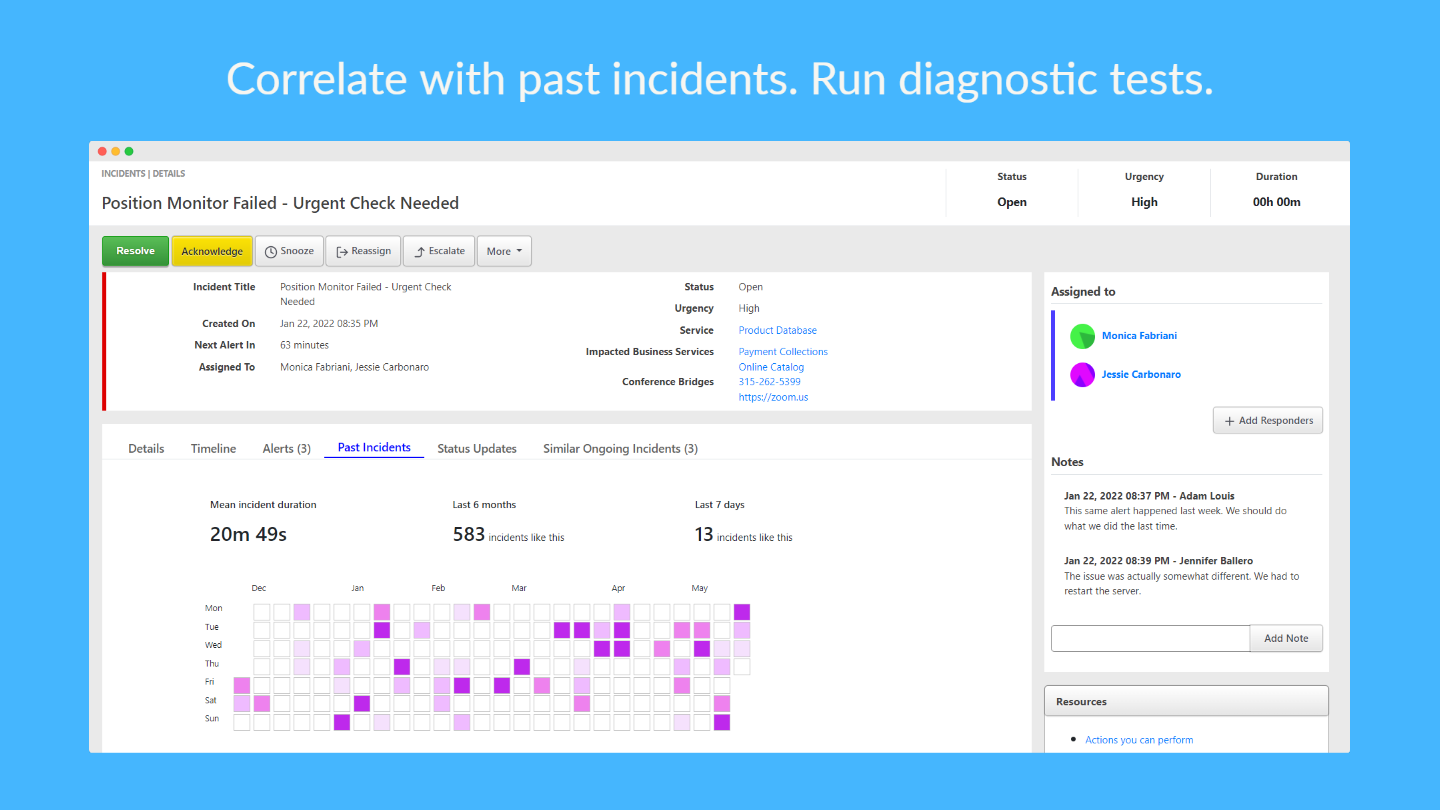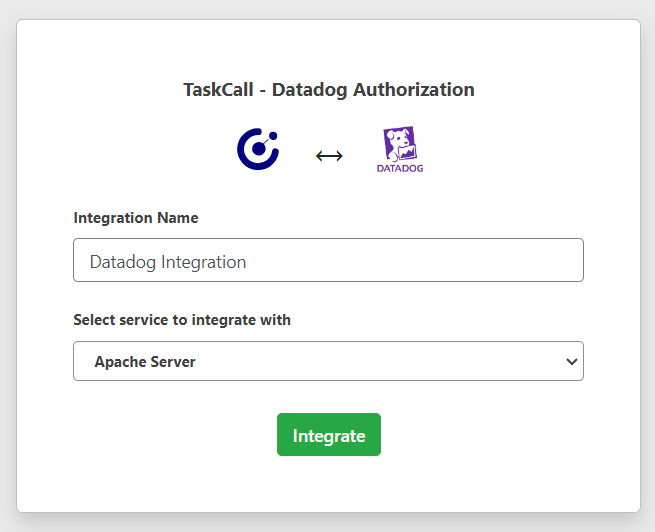- Essentials
- Getting Started
- Datadog
- Datadog Site
- DevSecOps
- Serverless for AWS Lambda
- Agent
- Integrations
- Containers
- Dashboards
- Monitors
- Logs
- APM Tracing
- Profiler
- Tags
- API
- Service Catalog
- Session Replay
- Continuous Testing
- Synthetic Monitoring
- Incident Management
- Database Monitoring
- Cloud Security Management
- Cloud SIEM
- Application Security Management
- Workflow Automation
- CI Visibility
- Test Visibility
- Test Impact Analysis
- Code Analysis
- Learning Center
- Support
- Glossary
- Standard Attributes
- Guides
- Agent
- Integrations
- OpenTelemetry
- Developers
- Authorization
- DogStatsD
- Custom Checks
- Integrations
- Create an Agent-based Integration
- Create an API Integration
- Create a Log Pipeline
- Integration Assets Reference
- Build a Marketplace Offering
- Create a Tile
- Create an Integration Dashboard
- Create a Recommended Monitor
- Create a Cloud SIEM Detection Rule
- OAuth for Integrations
- Install Agent Integration Developer Tool
- Service Checks
- IDE Plugins
- Community
- Guides
- Administrator's Guide
- API
- Datadog Mobile App
- CoScreen
- Cloudcraft
- In The App
- Dashboards
- Notebooks
- DDSQL Editor
- Sheets
- Monitors and Alerting
- Infrastructure
- Metrics
- Watchdog
- Bits AI
- Service Catalog
- API Catalog
- Error Tracking
- Service Management
- Infrastructure
- Application Performance
- APM
- Continuous Profiler
- Database Monitoring
- Data Streams Monitoring
- Data Jobs Monitoring
- Digital Experience
- Real User Monitoring
- Product Analytics
- Synthetic Testing and Monitoring
- Continuous Testing
- Software Delivery
- CI Visibility
- CD Visibility
- Test Optimization
- Code Analysis
- Quality Gates
- DORA Metrics
- Security
- Security Overview
- Cloud SIEM
- Cloud Security Management
- Application Security Management
- AI Observability
- Log Management
- Observability Pipelines
- Log Management
- Administration
TaskCall
Supported OS




Incident Notifications
Incident Details
Impact Visibility and Status Dashboard
On-Call Management
Overview
TaskCall is a real-time incident response system that reduces system downtime by automating the response process. It continuously accepts feeds from monitoring tools to provide a comprehensive view of your system. It uses its on-call management and incident response mechanisms to assemble the right team and resolve incidents in the fastest possible time.
TaskCall’s integration allows Datadog users to bolster their operations by improving their incident awareness and simplifying the process in which they are handled. Incidents sync up bi-directionally between the two platforms. Once Datadog alerts are received in TaskCall, users can systematically manage all incidents without being interrupted. Users also benefit from improved impact visibility from dependency graphs and status dashboards. With a better understanding of the state of your overall infrastructure, efficient resolutions can be achieved.
Key Features
- Correct on-call responders are notified as soon as an alert is received from Datadog.
- Repeating alerts are automatically silenced to avoid interrupting the on-call responders when they are already looking at the incident.
- The integration is bi-directional. Status and priority are synced up between Datadog and TaskCall.
- Incidents are automatically resolved in TaskCall when alert conditions are no longer present.
- This integration is available on all TaskCall subscription plans.
Setup
The integration needs to be configured from both TaskCall and Datadog.
Install TaskCall App in Datadog
- Create a TaskCall account if you do not already have one.
- In Datadog: Navigate to the TaskCall integration tile.
- On the TaskCall integration tile, go to the Configure tab and click Connect Accounts. You will be redirected to TaskCall.
- In TaskCall: Give the integration a name and select the service you want the integration to be on.

- Click Integrate. You will be redirected to a Datadog authorization page.
- Authorize the integration, ensuring that you have the correct permissions to do so.
- Once you authorize the integration you will be redirected to TaskCall.
- In TaskCall: Copy the Integration Url that is issued for the integration. You will need this to set up the webhook in Datadog.
Create Webhook in Datadog
- Go to Integrations > Integrations.
- Find Webhooks and click on it.
- Click on the New Webhook button.
- Give it a name and paste the Integration Url you copied over from TaskCall.
- Copy the following JSON payload and paste it in the Payload section.
{
"body": "$EVENT_MSG",
"last_updated": "$LAST_UPDATED",
"event_type": "$EVENT_TYPE",
"title": "$EVENT_TITLE",
"date": "$DATE",
"org": {
"id": "$ORG_ID",
"name": "$ORG_NAME"
},
"id": "$ID",
"aggreg_key": "$AGGREG_KEY",
"alert": {
"cycle_key": "$ALERT_CYCLE_KEY",
"id": "$ALERT_ID",
"metric": "$ALERT_METRIC",
"scope": "$ALERT_SCOPE",
"status": "$ALERT_STATUS",
"title": "$ALERT_TITLE",
"transition": "$ALERT_TRANSITION",
"type": "$ALERT_TYPE",
"query": "$ALERT_QUERY"
},
"user": "$USER",
"username": "$USERNAME",
"priority": "$PRIORITY",
"text_msg": "$TEXT_ONLY_MSG",
"snapshot": "$SNAPSHOT",
"link": "$LINK",
"hostname": "$HOSTNAME",
"incident_uuid": "$INCIDENT_UUID",
"incident_public_id": "$INCIDENT_PUBLIC_ID",
"incident_title": "$INCIDENT_TITLE",
"incident_url": "$INCIDENT_URL",
"incident_msg": "$INCIDENT_MSG",
"incident_severity": "$INCIDENT_SEVERITY",
"security_rule_id": "$SECURITY_RULE_ID",
"security_rule_name": "$SECURITY_RULE_NAME",
"security_signal_severity": "$SECURITY_SIGNAL_SEVERITY",
"security_signal_title": "$SECURITY_SIGNAL_TITLE",
"security_signal_msg": "$SECURITY_SIGNAL_MSG",
"security_rule_query": "$SECURITY_RULE_QUERY",
"security_rule_type": "$SECURITY_RULE_TYPE",
"tags": "$TAGS"
}
- Once the details have been entered, click Save.
For more information, see the TaskCall Datadog Integration Guide.
Uninstallation
- In TaskCall, delete the integration from Services > Integrations.
- Navigate to the TaskCall integration tile in Datadog and uninstall it. You must also delete the webhook you created to send notifications to TaskCall.
- Once this integration has been uninstalled, any previous authorizations are revoked.
Support
Contact TaskCall support for any questions regarding the integration or the platform.
